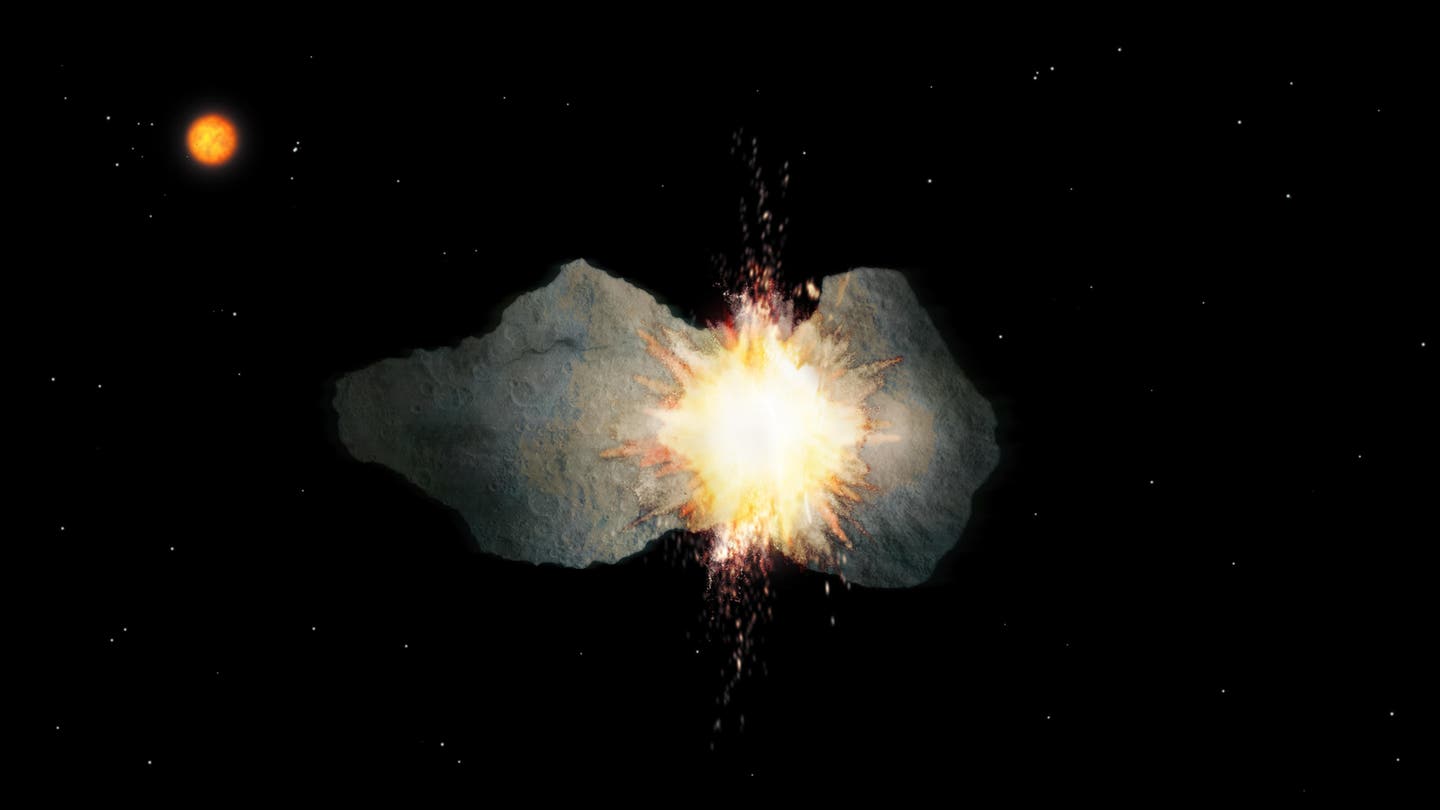AI and Gaia data reveal why some asteroids spin and others tumble
AI and Gaia data reveal how asteroid collisions and sunlight shape rotation, offering new insight into planetary defense.

An illustration of two colliding asteroids. Using Gaia data and AI models, researchers uncovered why some asteroids tumble while others spin smoothly. (CREDIT: Europlanet/T Roger)
Asteroids might seem like peaceful drifters suspended in space, but they're really disturbed, spinning and tumbling in complex motion that holds clues to their past. A new study presented at the European Planetary Science Congress–Division for Planetary Sciences Joint Meeting in Helsinki has uncovered that an asteroid's rotation—whether smooth or spinning chaotically—is founded on how often it has impacted other space rocks.
The finding, drawn from observations by the European Space Agency's Gaia mission, may assist astronomers in better comprehending how to deflect potentially harmful asteroids that are en route to Earth.
University of Tokyo's Dr. Wen-Han Zhou, the project lead researcher, described the findings as offering a new chapter in the history of these ancient objects. "With the use of Gaia's unique dataset, advanced modeling, and AI capabilities, we have unveiled the hidden physics driving asteroid rotation and shed light on the interior of these ancient worlds," he explained.
The Cosmic Fingerprint of Rotation
As Gaia observed the entire sky, it compiled a vast database of asteroid light curves—measurements of the way each asteroid's brightness changes with each rotation. Plotted against spin rate and size, changes in the light indicated a strange gap between two groups.
Zhou's researchers wondered why. With colleagues at France's Observatoire de la Côte d'Azur, he created a model of how the spins of asteroids evolve over time. The model highlighted two competing forces: collisions within the asteroid belt that can cause asteroids to be knocked into a tumble, and internal friction that stabilizes them back into a regular spin over time.
When the two effects are in equilibrium, they create a natural border in the asteroid population," said Zhou. The scientists tested the hypothesis by applying machine learning to Gaia's data and comparing the output to predictions of their model. The match was almost perfect.
Below the gap are slowly falling asteroids with rotation periods of less than 30 hours. Above them, the faster-rotating, uniformly spinning ones. This straightforward rule had puzzled astronomers for decades, but Zhou's model revealed the subtle tug-of-war creating it.
A Clash of Collisions and Sunlight
Scientists have been stumped for decades by the fact that so many asteroids seem to roll over rather than spin neatly. The new research suggests that gradual rotation sets an asteroid up to be knocked off course by an impact. Even a glancing blow from another rock puts it into a frenzied spin.
Typically, sunlight can act as a gentle finger that stabilizes objects rotating in space. As an asteroid absorbs sunlight and radiates away the heat, it is pushed by photons that emerge. Over time, this process—the Yarkovsky–O'Keefe–Radzievskii–Paddack, or YORP, effect—is capable of changing its spin rate. For regularly spinning asteroids, this solar push is continuous, slowly accelerating them or decelerating them in a steady direction.
But for tumbling asteroids, the influence of sunlight is less. Their uncontrolled motion causes the heat to be re-emitted in every direction, eliminating any persistent push. Instead of being spun into increased rotation, these asteroids are trapped in slow, unstable motion. That is the reason for so many slow, small rotators appearing to be trapped below the dividing line in Gaia's data.
Windows Into Ancient Interiors
Aside from solving a long-standing mystery, the findings offer a way to study the insides of asteroids indirectly. The way an asteroid rotates dictates its internal solidity or looseness. By matching Gaia's observations of asteroid rotation against theoretical models of internal composition, scientists can deduce what kinds of materials these bodies are made of—without the need to send a spacecraft to each one.
The evidence up to now all point to the fact that many asteroids are "rubble piles"—collections of boulders and dust bound together by gravity as opposed to solid rock. These porous bodies filled with cavities and thick veneers of dusty regolith. In such a composition, their response to impacts or flybys by other objects is predetermined.
Understanding this internal structure is the key to planetary defense. If a potential threatening asteroid is discovered on a collision course with Earth, the best way to deflect it would depend on its composition. A loose rubble pile would react quite differently to kinetic impacts, such as NASA's Double Asteroid Redirection Test (DART), than a dense solid object. Zhou's research provides the foundation for more accurately predicting such reactions.
Mapping Millions of Asteroids in the Future
Gaia's results are only the beginning. Upcoming surveys, including the Vera C. Rubin Observatory's Legacy Survey of Space and Time (LSST), will examine millions more asteroids along the sky. Zhou said that this will allow scientists to create better models of spin evolution and better understand how these objects have evolved and formed over billions of years.
With subsequent surveys like the LSST, we'll be able to apply this method to millions more asteroids, and refine our understanding of their composition and history," explained Zhou.
These large datasets will allow scientists to build a more detailed "family tree" of asteroids—informing us which are survivors of ancient impacts, which are reliable survivors, and which may one day come close to Earth.
Practical Implications of the Research
This study's impact goes far beyond the asteroid belt. By deciphering the code of impacts and sunlight on the rotation of asteroids, scientists are provided with a powerful tool with which to measure the inner composition of these rocky bodies. That information could be the difference between success and failure in future planetary defense missions designed to prevent disastrous impacts.
Whether an asteroid was a loose clump of trash or a solid hunk may be the difference between a successful deflection and one that ends in failure. As scientists fill out asteroid catalogues with missions like Gaia and LSST, they'll know which objects actually represent a threat—and what to do about them.
On a larger scale, the science teaches us about the early solar system's history. Every wandering asteroid carries with it the history of its collisions, sun-warming radiation, and gravitational encounters over the course of billions of years. By studying their spin, scientists are reading history in motion.
Research findings are available online in euroPLANET.
Related Stories
- The asteroid belt is slowly vanishing, shedding dust and rocks
- Astronomers weigh nuclear option to stop Moon-bound asteroid
- Astronomers discover hidden link between M and K-type asteroids
Like these kind of feel good stories? Get The Brighter Side of News' newsletter.
Shy Cohen
Science & Technology Writer



